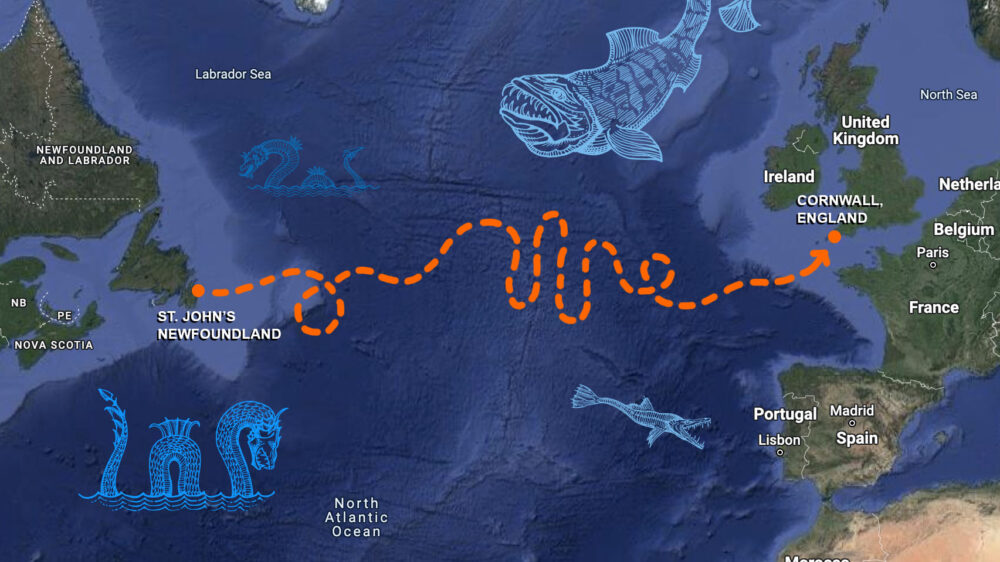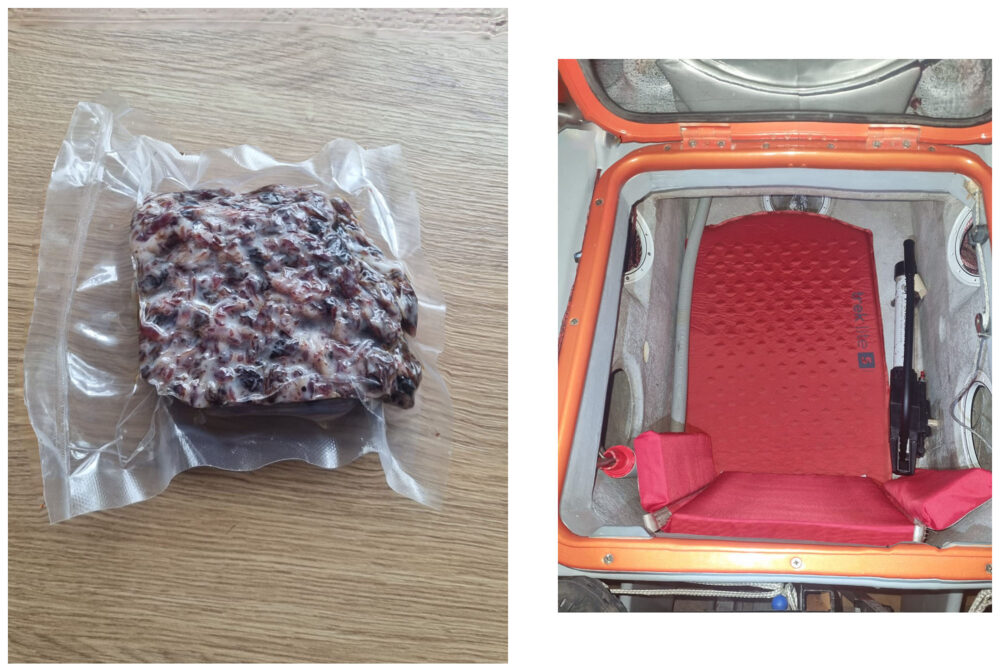Crossing the Atlantic in a 3.5-foot boat is a risky trip that will be punishing on the body. Andrew Bedwell is stoked.
Andrew Bedwell has invited dozens of people to board his sailboat, and not a single person has liked it. “When you get in it for the first time, everyone… is like, oh my God, this is awful,” he says, nonplussed. Bedwell has already gotten used to what it’s like to cram himself inside the tiny area below deck of his 3.5-foot micro yacht, Big C. For scale, Bedwell is 6 feet tall. Now imagine him sitting in a half-sized bathtub, pelted by saltwater, for weeks on end.
In May 2023, Bedwell will embark on a world-record attempt for the smallest vessel to cross the Atlantic. He’ll launch from St. John’s, Newfoundland, on Canada’s eastern coast and travel 1,900 nautical miles to Cornwall, England. It promises to be a grueling, 60 to 90-day trip—roughly two to three times longer than crossing on a larger vessel.
Bedwell grew up with adventurous parents who owned a boat shop and pushed him to explore. “I like doing challenges, real challenges,” he says. And he wanted to do a big one before turning 50 (he’s 48). With 20 years of experience guiding others in extreme sports and a strong sailing background, he stumbled across books about previous voyages by solo sailors, records unbroken for decades. “The seed was sown straight away.”
The adventure has aroused equal parts curiosity and ire among fellow sailors (social media comments range from awe-inspired to downright cruel). But Bedwell says he’s well-prepared for the journey’s physical and psychological dangers.
“Effectively, this boat is a big buoy. It’s designed to stay afloat,” Bedwell says. But the vessel’s buoyancy, coupled with its tiny stature, also means it’s responsive to every movement.
“You get on a boat and you expect everything to be stationary,” he says. But on Bedwell’s boat, “You lean forward and the whole boat will tip forward. You lean back and the whole boat will tip back.” People have described it as standing atop a medicine ball. But while the boat can lean, it is very hard to tip, allowing it to safely pitch and roll with the waves.
“Everything has got two, maybe three, uses,” Bedwell explains. His back support will hold an extra sail, and a cushion doubles as a legally mandated flotation device. He’ll be wearing an oversized dry robe, a mildly waterproof, warmly lined coat popular with swimmers, surfers, and divers that doubles as a sleeping bag. He won’t bring foul-weather gear, or “foulies.” Instead, Bedwell will rely on a plastic bubble that allows him to survey the boat and waves while staying dry inside, where he can just barely stretch his legs. He will have to sleep in the fetal position, with an e-reader as his only entertainment.
For the most part, he’ll be sitting with his knees slightly bent for the journey. In case of a mechanical failure, he can climb up on deck wearing a safety harness. But Bedwell doesn’t expect to be on deck in foul weather. He’s overengineered the boat to be extra-tough for its size, with 6-millimeter forestay cables. Strong enough for a boat 10 times the size of Big C, these taut cables connect the mast to the bow, and are the only part of the boat Bedwell can’t easily access.
Online, Bedwell has his detractors. Some are live-aboard sailors on small sailboats, who think the journey is unnecessarily dangerous. Others see no point in the adventure of a man whose only guarantee seems to be suffering. Critics say that a support boat that will follow Bedwell at a 24-hour gap devalues the trip as a solo journey; Bedwell points out that the support boat was a demand from public safety officials.

The struggle of sitting still
University of Houston exercise physiologist Melissa Markofski says we can look to ICU patients to understand the health risks of being confined to a small space and eating a repetitive diet. She is not worried about Bedwell’s plan to survive on sports drinks and homemade pemmican, a jerky-like substance first concocted by Indigenous explorers. Bedwell’s will contain dried meat, raisins, fat, and medications, including a blood thinner.
“It’s usually not a problem to make a specialized food like he’s going to have. We do this all the time in clinical settings,” Markofski says. People can receive feeding through nasogastric tubes, for example, for months or even years. And 90 days is not that long to be on a limited diet, she adds. A bigger problem is simply sitting still for so long.
“I wouldn’t advise this being an annual thing.”
Pressure sores are a potential concern, and Bedwell will need to change his position frequently, ideally every couple hours, even if it just means shifting slightly to one side or the other. Digestion will also slow down, Markofski says, so making sure the pemmican supports easy digestion could prevent constipation and other discomforts.
Most challenging will be the potential loss of muscle mass in the lower body, which will begin just days into the trip. Stretching as possible and doing weight-bearing exercises like squats could help, though Bedwell would have to stand on deck to do them. Bedwell also plans to use his feet to operate a desalinator that generates drinking water. But no matter how much he does, Markofski expects muscle mass recovery will take three to six months: “I wouldn’t advise this being an annual thing.”

Left: Vacuum-packed pemmican made from dried meat, fat, raisins, and various daily medicines including a blood thinner. Right: The inside of the vessel, which includes a back pad that doubles as a flotation device. Andrew Bedwell
Many dangers at sea
Josh Colvin, publisher of Small Craft Advisor magazine, says Bedwell’s “survival capsule” approach is similar to that of Hugo Vihlen, the current record holder. “It’s mostly a mental challenge,” he says. “Imagine doing what Andrew is doing without ever leaving your house.”
Plenty of less adventurous sailors have been lost at sea. On a 1981-82 trip, Steven Callahan spent 76 days adrift in the Atlantic on an inflatable liferaft. Gear failure is another hazard, along with potential collisions with large vessels in shipping lanes.
“Container ships are notorious for running small boats down,” Colvin says. Past record holder Tom McNally, who made an Atlantic crossing in a boat just 5 feet, 4.5 inches long, was struck by a ferry, whose operator seemed not to notice. But McNally’s generator was broken, his provisions thrown overboard, and he survived on raw fish for the next month.
Even with a radar reflector and radio to alert larger vessels, Bedwell will have to balance sleep with staying alert, particularly because his tiny boat can’t quickly maneuver out of the way if he spots impending danger in the darkness.
“You can be out there on an 80-foot, crewed boat and still have gigantic problems and potentially lose your boat or your life.”
“I think it’s doable, but it’s still a tremendous challenge,” Colvin says. Rob Dubin would agree. A liveaboard sailor, he spent 17 years circumnavigating the globe aboard a more reasonably sized 40-foot sailboat with his wife, Dee. Dubin also spent years of his career as a filmmaker, chronicling other adventurers. Now he’s a motivational speaker. “The biggest question we all face in our lives… is if you’re going to step up and step outside of your comfort zone, grow and become a bigger, better, more capable person,” he says.
Still, on the open ocean, luck plays a role. “You can be out there on an 80-foot, crewed boat and still have gigantic problems and potentially lose your boat or your life,” Dubin says. “Nothing’s guaranteed.” As to the naysayers, Dubin says, “He’s got together as much as any of us do when we go offshore.”
He also has a mission. Bedwell’s boat was designed and partially built by Tom McNally, who hoped to raise money to fight cancer while reclaiming his world record. But McNally succumbed to cancer before Big C was finished. Bedwell completed the build and will now pursue McNally’s fundraising mission alongside his record attempt. He plans to spread some of McNally’s ashes en route.
Bedwell has visited his doctor, hyper-engineered his vessel, created a personalized recipe to nourish himself, and consulted past record setters to craft the best conditions for success. There’s one thing he isn’t worried about: seasickness. He expects riding in the capsule to be, in a word, awful (“tumble, tumble, tumble”). But his head will be in a padded dome and he says he’s never really been seasick. “The only thing we joke about is that I’m not going to see a psychiatrist,” he says. “They’d drop me straightaway.”












